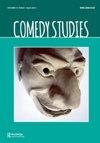Comic license in contemporary African American visual art
Q1 Arts and Humanities
引用次数: 0
Abstract
Abstract Given a dominant visual discourse predicated upon stereotypes concerning menace, sexualisation, and abjection, African American visual production is often obligated to effect a correction by producing responsible, even didactic art. While this imperative remains a potent force, in this paper I focus upon work that is determinedly irreverent, even comic in its forthright address of race. My case studies are three African American artists: William Pope.L, a performance artist self-styled as the “Friendliest Black Artist in America”; a visual artist, Sanford Biggers, and a conceptual artist, Dave McKenzie. I suggest that all three create work that, in favouring the comic rather than the tragic modality, extends the affective possibilities for black expression. The comedy is not necessarily about generating laughter, rather, as a form of what Lauren Berlant calls ‘deadpan aesthetic,’ its ambivalence engenders a deliberate and productive uncertainty.当代非裔美国人视觉艺术中的漫画许可证
摘要鉴于主流视觉话语建立在关于威胁、性化和贬斥的刻板印象之上,非裔美国人的视觉作品往往有义务通过制作负责任的、甚至是说教性的艺术来进行纠正。虽然这种必要性仍然是一种强大的力量,但在本文中,我关注的是那些坚决不敬的作品,甚至是直接针对种族的漫画作品。我的案例研究是三位非裔美国艺术家:威廉·波普,一位自称“美国最友好的黑人艺术家”的行为艺术家;视觉艺术家桑福德·比格斯和概念艺术家戴夫·麦肯齐。我建议三人创作的作品都倾向于喜剧而非悲剧形式,从而扩展了黑人表达的情感可能性。这部喜剧不一定是为了制造笑声,相反,作为劳伦·贝兰特所说的“面无表情的美学”的一种形式,它的矛盾心理产生了一种深思熟虑的、富有成效的不确定性。
本文章由计算机程序翻译,如有差异,请以英文原文为准。
求助全文
约1分钟内获得全文
求助全文
来源期刊

Comedy Studies
Arts and Humanities-Literature and Literary Theory
CiteScore
0.60
自引率
0.00%
发文量
26
 求助内容:
求助内容: 应助结果提醒方式:
应助结果提醒方式:


